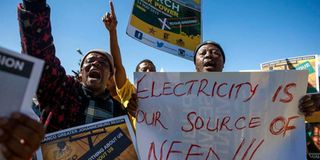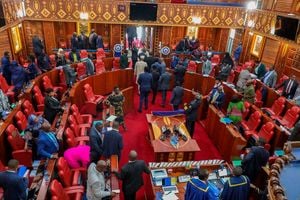African power giant Eskom pushes S African economy to the brink

South Africans march against South African power supplier ESKOM and to protest against power cuts on May 14, 2015 in Soweto district of Johannesburg, South Africa.
South Africa is enduring yet another round of severe power outages, increasing pressure on this country's heavily stressed economy.
Daily outages of several hours are affecting all parts of the country, hampering industry, agriculture and commerce, and costing billions in lost revenues and production.
Despite the best efforts of new management, the country's debt-ridden and ailing power producer Eskom is staggering from crisis to crisis, as poor and corrupt management over more than two decades has caught up with it.
The prospects are that the 'rolling blackouts', which have already trimmed around one percent per annum from the Gross Domestic Product (GDP) since they set in late in 2007, will continue to hit the S African economy hard.
Since 2014, the blackouts have become ever-more intense and frequent, with many businesses falling back on their own generation of power to keep operating, as have homeowners who can afford solar or other backups.
Raiding state coffers
Following the severe impacts of a decade of intensive raiding of state coffers, termed 'state capture', and related corruption, plus the impact of the Covid-19 pandemic, the S African economy had been showing signs of 'green shoots' recovery.
But it has been set back, especially in its most populous region, KwaZulu-Natal, which was hit last week by historic floods, causing widespread infrastructural damage, and last July by mass looting and arson attacks.
Economists are still estimating last week's flood impacts, but they are certain to run into several billion dollars, while the cost of last July's 'failed insurrection', triggered by the jailing of former president Jacob Zuma, is estimated to have cost over $3.3 billion, according to President Cyril Ramaphosa.
The net result is that an economy that suffers an effective unemployment rate of over 46 percent, mostly affecting the youth among whom only one in three has a job, has been barely coping.
But with each successive round of blackouts – Eskom having warned that as many as 101 days of electricity blackouts are to be expected this year – the economy takes another knock.
It has been estimated that each day of multi-hour blackouts costs the economy around $330,000, with the poorest sectors suffering the worst effects, including lost service delivery where such services are already scarce or intermittent.
On paper, there is no good reason that S Africa should be so severely pressed in terms of predictable demand.
According to the Ministry of Mineral Resources and Energy, South Africa's total domestic electricity generation capacity is 58.095 gigawatts (GW) from all sources.
Eskom's share of this is 44GW, of which 38GW is from coal-powered stations.
But capacity on paper is one thing, reliable production another.
With an average national daily requirement of about 30GW, Eskom has, in round after round of blackouts, been forced to cut supply to customers, sometimes falling short by several gigawatts when planned outages for repairs and maintenance are compounded by unplanned outages.
Poor planning
This is in part the result of poor planning and due to money wasted that should have been spent in years and decades past on now long-overdue maintenance.
And that is the core of the country's power issues: an ageing fleet of increasingly unreliable coal-fired power stations that are nevertheless contributing significantly per capita to global carbon dioxide and related coal emissions, which in turn contribute to global warming and climate change – and therefore to extreme weather events, such as the recent KwaZulu-Natal inundations that claimed at least 435 lives, with dozens still unaccounted for and presumed dead.
In all, Eskom operates 15 coal-fired power stations that generate more than 80 percent of the country's electricity, but which break down far more frequently than they should.
Eskom also runs Africa's only nuclear power station at Koeberg, near Cape Town, plus a clutch of smaller pumped storage, hydroelectric, backup gas plants and a wind farm.
Eskom takes only a tiny fraction of the country's power needs from independent power producers, who are allowed, under tight government control, to sell electricity back into the national grid.
But elements within the ruling party – most notably in the context of power production, Minister of Mineral Resources and Energy Gwede Mantashe, a former unionist and keen supporter of new coal and nuclear power plants – are fighting the outsourcing of electricity contributions from private-sector interests at every turn.
Outages
Last year, with pressure increasing on it with each renewed bout of outages, the Ramaphosa government unveiled eight preferred independent power producers to produce 1.845GW of additional electricity to support Eskom.
But that will take time to come on line as the costly outages continue.
Despite being significantly cheaper than coal-sourced electricity and demonstrating real-world low-cost reliability, both solar and wind renewable power production by independents hoping to fill S Africa's near-constant power shortages have been largely thwarted by Mantashe and others who wish to maintain the state's effective monopoly on power production, mainly for ideological reasons.
With an annual turnover shortfall likely to persist, despite efforts to rein in corruption, maladministration and misspending, Eskom's financial position is very weak, owing some $26 billion against revenues last year of $9 billion.
Despite efforts to reduce the state utility's debt burden, there is nothing that can be done quickly to turn back 30 years of failed servicing and refurbishments to its ageing coal-fired plants, now on average 42 years old and nearing the end of their natural lifespans.
Adding to Eskom's woes is that the Koeberg nuclear power station, producing at capacity 1.86GW from two units, is nearing the end of its design-life of 40 years.
Recently the national energy regulator, theoretically a state institution separate in its oversight of the energy sector, gave the green light to Eskom to extend the lifetime of Koeberg by 20 years, and one of the nuclear plant's two units is already under refurbishment.
That has drawn severe criticism from concerned citizens, some of whom have been vocally and actively 'anti-nuke' over safety issues from the outset of Koeberg's construction in the mid-1970s.
Despite the outcry, the government is determined to go ahead with the extension of Koeberg's operational life, largely because it has little alternative in the short to medium term.
So constrained has power production been that S Africa has cut back on its former average of 1.413GW exports of electricity, mainly to Zimbabwe, against fixed contracts of 1.83GW.
Local authorities
The reduced supply prompted the Zimbabwean government to announce this week that it would have to look to Zambia for its additional electricity needs.
Another element in Eskom's seemingly insoluble collective of problems is the non-payment by ANC-controlled local authorities and municipalities for electricity supplied, amounting to $2.73 billion.
The ongoing problems are having regional effects beyond Zimbabwe and forcing governments in the region to consider major infrastructure projects to potentially tap into vast hydroelectric power production prospects in the Congo.
In all, Africa has 147GW of installed capacity, equivalent to the new power capacity installed in China every 18 months to two years.
After South Africa, the countries with the highest installed capacity on the continent are Nigeria (12.522GW, although only around 3GW of this is dispatchable most days), Ghana (4.399GW), Ethiopia (4.244 GW), Kenya (2.819GW), DRC (2.677GW), Zimbabwe (2.24GW), Botswana (920MW) and Senegal (864 MW).
Electricity scarcity is a continent-wide issue, with an average 43 percent access rate to electricity, half of the global access rate of 87 percent.
But until S Africa deregulates its power supply inputs to a much greater degree, the continent's leading industrial, mining and commercial economy will not be contributing much if anything to getting more electricity to more Africans – at least, not any time in the foreseeable future.





